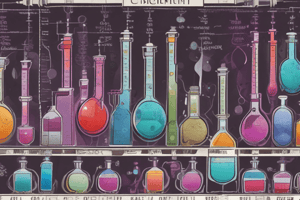Podcast
Questions and Answers
What is Biochemistry?
What is Biochemistry?
Biochemistry is the branch of science that explores the chemical processes within and related to living organisms. It is a laboratory based science that brings together biology and chemistry.
What is the difference between acids and bases?
What is the difference between acids and bases?
Acids are compounds that contain ionizable hydrogen (H+) or proton and are proton donors. Bases are compounds which accept ionizable hydrogen (H+) or proton and are proton acceptors. Bases can provide OH-.
What is pH scale?
What is pH scale?
The negative logarithm of the hydrogen ion concentration. pH= -log[H+]. [H+] is the concentration of hydrogen. Range is from 0 - 14. If [H+] is high, the solution is acidic; pH < 7. If [H+] is low, the solution is basic or alkaline; pH > 7. If pH = 7, the solution is neutral.
What are buffers and their types?
What are buffers and their types?
Define alkalosis and acidosis.
Define alkalosis and acidosis.
Define buffer and state their mechanism of action
Define buffer and state their mechanism of action
Enumerate the physiological buffers.
Enumerate the physiological buffers.
Contrast the causes and compensations of acidosis and alkalosis
Contrast the causes and compensations of acidosis and alkalosis
The negative logarithm of the hydrogen ion concentration is _____.
The negative logarithm of the hydrogen ion concentration is _____.
Physiological _____ systems are Bicarbonate buffer, Phosphate buffer, Protein buffer, and Haemoglobin buffer.
Physiological _____ systems are Bicarbonate buffer, Phosphate buffer, Protein buffer, and Haemoglobin buffer.
_____condition in which the ratio of bicarbonate to carbonic acid is decreased below 20:1.
_____condition in which the ratio of bicarbonate to carbonic acid is decreased below 20:1.
Flashcards
What is biochemistry?
What is biochemistry?
The study of chemical processes within and related to living organisms, bringing together biology and chemistry.
What are acids?
What are acids?
Compounds containing ionizable hydrogen (H+) or protons; they are proton donors.
What are bases?
What are bases?
Compounds that accept ionizable hydrogen (H+) or protons; they are proton acceptors and can provide OH-.
What is pH?
What is pH?
Signup and view all the flashcards
What are buffers?
What are buffers?
Signup and view all the flashcards
What is an acidic buffer?
What is an acidic buffer?
Signup and view all the flashcards
What is a basic buffer?
What is a basic buffer?
Signup and view all the flashcards
What are physiological buffers?
What are physiological buffers?
Signup and view all the flashcards
Bicarbonate buffer system
Bicarbonate buffer system
Signup and view all the flashcards
How do lungs control blood pH?
How do lungs control blood pH?
Signup and view all the flashcards
What are chemoreceptors?
What are chemoreceptors?
Signup and view all the flashcards
How do kidneys control blood pH?
How do kidneys control blood pH?
Signup and view all the flashcards
What is acidosis?
What is acidosis?
Signup and view all the flashcards
What is alkalosis?
What is alkalosis?
Signup and view all the flashcards
What causes respiratory acidosis?
What causes respiratory acidosis?
Signup and view all the flashcards
What causes respiratory alkalosis?
What causes respiratory alkalosis?
Signup and view all the flashcards
How is metabolic acidosis compensated?
How is metabolic acidosis compensated?
Signup and view all the flashcards
How is metabolic alkalosis compensated?
How is metabolic alkalosis compensated?
Signup and view all the flashcards
What are the main causes of metabolic acidosis?
What are the main causes of metabolic acidosis?
Signup and view all the flashcards
What are the main causes of metabolic alkalosis?
What are the main causes of metabolic alkalosis?
Signup and view all the flashcards
Study Notes
- Biochemistry explores chemical processes in living organisms and is lab-based, combining biology and chemistry
Acids
- Acids are compounds containing ionizable hydrogen (H+) or protons
- Acids serve as proton donors
- Strong acids dissociate completely and irreversibly in solution (e.g., HCl -> H+ + Cl-)
- Weak acids dissociate incompletely and reversibly in solution (e.g., CH3COOH ⇆ CH3COO- + H+)
Bases
- Bases accept ionizable hydrogen (H+) or protons
- Bases act as proton acceptors
- Bases can provide OH- ions
- Strong bases dissociate completely and irreversibly in solution (e.g., NaOH -> Na+ + OH-)
- Weak bases dissociate incompletely and reversibly in solution (e.g., NH4OH ⇆ NH4+ + OH-)
pH Scale
- pH is the negative logarithm of hydrogen ion concentration: pH = -log[H+]
- [H+] represents the concentration of hydrogen ions
- The pH scale ranges from 0 to 14
- At high [H+], pH < 7, indicating an acidic solution
- At low [H+], pH > 7, indicating a basic or alkaline solution
- pH = 7 indicates a neutral solution
Buffers
- Buffers resist pH changes upon addition of small amounts of acids or bases
- They neutralize small amounts of added acid or base, maintaining pH stability
- Excessive amounts of acids or bases can cause significant pH changes, even with buffers, due to buffer capacity
- Acidic buffers are composed of a weak acid and a salt of that acid with a strong base
- Basic buffers are composed of a weak base and a salt of that base with a strong acid
Physiological Buffers
- Physiological buffers maintain constant pH in blood and tissues
- The physiological pH is around 7.4, optimal for plasma enzyme activity
- Body enzymes are sensitive to pH changes
- Physiological buffer systems include bicarbonate, phosphate, protein, and hemoglobin buffers
- Hemoglobin provides about 60% of the protein buffering capacity
- Hemoglobin buffers carbon dioxide added to the blood by tissues
Bicarbonate Buffer System
- The bicarbonate buffer system is present in higher concentrations than other buffers
- Carbonic acid is easily formed from CO2 by carbonic anhydrase in tissues
- The bicarbonate to carbonic acid ratio is 20:1 at pH 7.4
- Added acid is converted of HCO3 - to H2CO3, then to CO2 + H2O by carbonic anhydrase, disposing of CO2 by the lungs
- The ratio of bicarbonate to carbonic acid decreases below 20:1 when acid is added to the blood
Organs Controlling Blood pH
- Lungs
- Chemoreceptors in the medulla sense pH changes, adjusting breathing rate and depth to compensate
- Kidneys regulate blood pH through reabsorption of HCO3- and excretion of H+ in the urine
Acidosis
- Acidosis is a condition where the bicarbonate to carbonic acid ratio is decreased below 20:1
- Types include respiratory and metabolic acidosis
Alkalosis
- Alkalosis is a condition where the bicarbonate to carbonic acid ratio exceeds 20:1
- Types include respiratory and metabolic alkalosis
Metabolic Acidosis
- Metabolic acidosis may be caused by increased acid production, renal failure, or excessive base loss
Increased Acid Production
- Severe muscular exercise leads to lactic acid accumulation
- High protein diets result in increased acid production
- Ketosis (excessive ketone body formation) occurs in uncontrolled diabetes mellitus and starvation
Renal Acidosis
- Renal acidosis is due to the failure of the kidneys to excrete acids
Excessive Base Loss
- Excessive base loss is caused by severe vomiting and diarrhea
Compensation of Metabolic Acidosis
- Compensations include an Increased rate of respiration to increase disposal of CO2
Respiratory Acidosis
- Respiratory acidosis involves increased blood levels of H2CO3 due to lungs failing to excrete CO2.
- Extensive lung disease (severe bronchial asthma, extensive emphysema, massive pneumonia, asphyxia)
- Depression of the respiratory center (for example: morphine poisoning)
Compensation of Respiratory Acidosis
- Increase the reabsorption of HCO3 –
- Increase the excretion of H+ in the urine
Respiratory Alkalosis
- Respiratory Alkalosis decreases the blood levels of H2CO3 due to hyperventilation
- Hyperventilation leads to increased excretion of CO2 by lungs (for example : in fevers and High altitudes )
Compensation of Respiratory Alkalosis
- Increase the excretion of HCO3 –
- Decrease the excretion of H+ in the urine
Metabolic Alkalosis
- Metabolic Alkalosis includes increase loss of acids and excessive absorption of bases
Increase Loss of Acids
- Loss of gastric juice (containing HCl) by vomiting in cases of pyloric stenosis or by prolonged suction in major operations.
Excessive Absorption of Bases
- Intake of large amounts of vegetables and fruits in diet which are rich in salts of organic acids (for example: sodium and potassium citrates) and bicarbonates.
- Administration of alkalis (for example: sodium and potassium citrates and bicarbonates) for treatment of peptic ulcer and hyperacidity.
Compensation for Metabolic Alkalosis
- Decrease the rate of respiration to increase CO2 in blood.
- Increase the excretion of HCO3 –
- Decrease the excretion of H+ in the urine
Studying That Suits You
Use AI to generate personalized quizzes and flashcards to suit your learning preferences.




